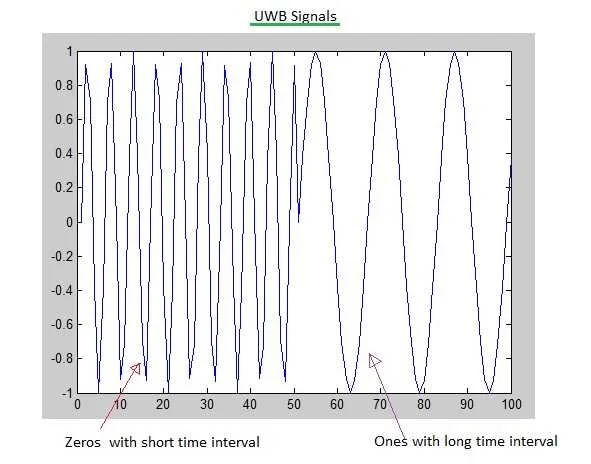UWB Tutorial
This Ultra Wideband (UWB) tutorial covers UWB basics including UWB working,benefits,modulation schemes,specifications and UWB applications.
UWB (Ultra Wideband) is a high speed short range wireless technology. It is introduced initially in IEEE 802.15.3a standard. The latest release defining specifications of UWB is specified in IEEE 802.15.4a. This standard mentions three frequency bands viz. below 1GHz, 3 - 5GHz and 6-10GHz.
How it works?

UWB use time shifting mechanism to transmit binary data at million pulses per second. Here zero is transmitted at short time intervals and one is transmitted at long time intervals. The UWB waveform is shown in figure-1.
At the receiver time interval between pulses define whether one or zero has been received. The figure-2 depicts UWB transmitter which is consists of binary data source, conversion of bits to symbols, symbols to pulses using pulse generator and RF part.


Figure-3 depicts UWB receiver consists of front end part and symbols to bits conversion. Front end part does acquisition, tracking and conversion of pulses to symbols. After bits conversion data conversion is taken place based on application need.
Modulation Schemes
UWB uses various modulation schemes based on application need. There are time based techniques and shape based techniques. Pulse position modulation(PPM) is used as time based modulation. PPM is simple technique but need fine time resolution in receiver.
BPM(Bi-phase modulation), OOK(On-Off Keying), PAM(Pulse Amplitude modulation), OPM(Orthogonal Pulse Modulation) etc. are used as shaped based modulation techniques. PAM and OOK are also simple binary only techniques but they have poor noise immunity. OPM is complex but it carry advantage of being orthogonal.
Benefits of UWB system
• As the UWB operates at low noise level conventional receivers will not be able to decode the signal and hence
it is one of the major technologies used for military communication.
• Being very low power signal it will not interfere with other wireless systems in the same frequency band.
• They can easily penetrate into the walls.
• The battery of UWB devices can last for longer duration due to its low power operation.
Typical specifications
• Frequency spectrum:3.1 5.15 and 5.825 to 10.6 GHz(DS-UWB),
4 bands(MB-OFDM)
• Bandwidth:1.368 GHz and 2.736GHz (for DS-UWB) and 528 MHz for MB-OFDM
• Range:10-30 meters
• Physical layers: MB OFDM or Direct Sequence UWB (DS-UWB)
• Data rate:1Gbps
• No. of simultaneous piconets:8(DS-UWB), 4(MB-OFDM)
Applications
• Consumer electronics for home entertainment networks and home networking
• Asset tracking in hospitals such as wheel chairs and beds
• Health care
• Military
• Medicine
UWB in Medicine
UWB is widely used in medicine for various applications. It include cardiology, respiratory medicine, obstetrics and Gynecology, in emergency room and for acute care, assistance for disabled people, throat and vocal cords monitoring etc.
